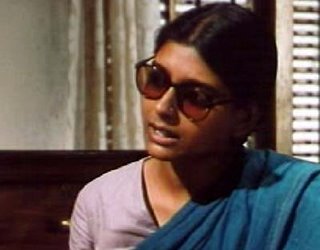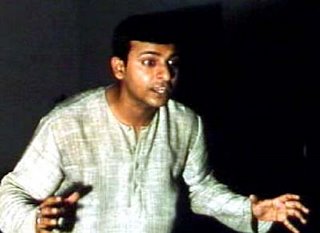 Hazaar Chaurasi ki Maa (Mother of 1084)
Hazaar Chaurasi ki Maa (Mother of 1084)
Directed, photographed and produced by Govind Nihalani
Starring Jaya Bachchan, Anupam Kher, Seema Biswas, Milind Gunaji, Nandita Das and Joy Sengupta
Music Debajyoti Mishra
From the cover:
Sujata Chatterjee is a middle aged, traditional, submissive, unprotesting, upper middle class lady, employed in a commercial bank in Calcutta. She awakens one early morning to the shattering news that her youngest and favourite son, Brati, is lying dead in the police morgue, reduced to a mere numerical: Corpse No. 1084. This awakening propels her on a journey of discovery, in the course of which, struggling to understand her Naxalite (militant leftist) son’s revolutionary commitment, she begins to recognise her own alienation as a woman and wife from the complacent, hypocritical bourgeois society her son had rebelled against. In an attempt to regain a sense of self from the intense psychological and emotional trauma, Sujata, as a mother, gains some deep insights into the complex relationship between the personal and the political.
 Brief illnesses are sometimes a blessing (if they aren’t accompanied by pain). The biggest advantage being that your boss doesn’t want you in the office and at home without anything better to do, you finish reading some unread books or watch those movies collecting dust on the shelves. For me it was the latter. I wanted to watch Hazaar Chaurasi ki Maa for long (in fact for the last eight years) but was somehow unable to, until my last short break from work.
Brief illnesses are sometimes a blessing (if they aren’t accompanied by pain). The biggest advantage being that your boss doesn’t want you in the office and at home without anything better to do, you finish reading some unread books or watch those movies collecting dust on the shelves. For me it was the latter. I wanted to watch Hazaar Chaurasi ki Maa for long (in fact for the last eight years) but was somehow unable to, until my last short break from work.
 Revolution is usually red signifying blood, but it is also has a romance attached to it. The Naxalbari Movement, referred to as the ‘first authentic Maoist phenomenon,’ was one such revolution. Though the part of the country where I grew up in was far detached from the May 25, 1967 happenings in Naxalbari (Darjeeling district, West Bengal) and its aftermath. By the time I was born, the movement had lost its initial steam. Today the offshoots of the movement are perceived as a major threat to the country’s security and much is being feared about the ‘Red Corridor’ from Telangana to Nepal. The general perception was not much different then too, just that the young and the educated felt for cause and many died for that. In today’s post-liberalisation India, the feelings lie elsewhere and perhaps the movement has also moved away from the ideals.
Revolution is usually red signifying blood, but it is also has a romance attached to it. The Naxalbari Movement, referred to as the ‘first authentic Maoist phenomenon,’ was one such revolution. Though the part of the country where I grew up in was far detached from the May 25, 1967 happenings in Naxalbari (Darjeeling district, West Bengal) and its aftermath. By the time I was born, the movement had lost its initial steam. Today the offshoots of the movement are perceived as a major threat to the country’s security and much is being feared about the ‘Red Corridor’ from Telangana to Nepal. The general perception was not much different then too, just that the young and the educated felt for cause and many died for that. In today’s post-liberalisation India, the feelings lie elsewhere and perhaps the movement has also moved away from the ideals.
 As a child hearing the names Charu Majumdar and Kanu Sanyal in adult discussion was common. I didn’t know who they were. Later as I grew up a little, some (it was usually the women) who had witnessed the upheaval in Bengal told me of an entire generation gone waste, other labelled them as martyrs for an honourable cause. The ideology appealed to me, the concepts of a classless society where all men are equal, were impressionable to a young mind but later understandings of the lack of individual liberties in the society for the cause brought in mixed feelings.
As a child hearing the names Charu Majumdar and Kanu Sanyal in adult discussion was common. I didn’t know who they were. Later as I grew up a little, some (it was usually the women) who had witnessed the upheaval in Bengal told me of an entire generation gone waste, other labelled them as martyrs for an honourable cause. The ideology appealed to me, the concepts of a classless society where all men are equal, were impressionable to a young mind but later understandings of the lack of individual liberties in the society for the cause brought in mixed feelings.
Our popular culture doesn’t understand the Naxalite. They are sometimes referred to as ‘misguided youths,’ politically correct terminology sounds nice to the ears, but the same can’t always be said for the heart. Else, merely dreaded ‘terrorists’ who need to be wiped away, as they systematically were.
 Though Hazaar Chaurasi ki Maa doesn’t delve into a deeper understanding of the cause and the effects, it does bring forward the lack of understanding (or knowledge) from even close family members. The enigma element remains till date. The support, the bonds and the betrayals are all there in the life of the revolutionary. And in death, a living, breathing, energetic individual is simply reduced to a mere number, four digits – one, zero, eight, four – so impersonal, so unattached, so ununderstanding and so insensitive. Death ushers one into the ultimate classless society.
Though Hazaar Chaurasi ki Maa doesn’t delve into a deeper understanding of the cause and the effects, it does bring forward the lack of understanding (or knowledge) from even close family members. The enigma element remains till date. The support, the bonds and the betrayals are all there in the life of the revolutionary. And in death, a living, breathing, energetic individual is simply reduced to a mere number, four digits – one, zero, eight, four – so impersonal, so unattached, so ununderstanding and so insensitive. Death ushers one into the ultimate classless society.
This was Jaya Bachchan’s comeback film, and what a wonderful one at that, controlled and an effective performance. The titles say ‘introducing’ Nandita Das and Joy Sengupta. Joy Sengupta is a fine actor, but isn’t seen much around. Nandita Das, in spite of her acclaimed performance, seemed overtly theatrical to me. Anyway it was Jaya’s film based Mahasweta Devi’s novel, Govind Nihalani played the able role of the facilitator.


so it seems finally you have managed some time to watch this movie. I’ve neither read the book nor have I seen the movie.
btw, what about the september issue of ispecial cutting chai??
oh!! you were ill?? hope you are fine now. you must be,when you are blooging that means you are fit!!
and now after reading half of the post I’ve something to say!!
nakshalbari movement!!
our school library still has an almirah on which the slogans were once written. the madam has not wiped away that and kept that intact as a memento. that was the the only experience I’ve directly!!
youth has always been the ‘gomukh’ of revolution… misguided or not, who m i to say
i’ve only managed to watch bits of this movie . didnt get around to watcing it all.
Nice post though. (i’m becoming repetitive)
you were not well?? hope you are better now.
Nice post…thoughtful one. We too have some Naxal folklore in kerala. Maybe there methods were wrong but the smug faced us have no right to question their intentions. Naxals have a very important place in our history – if they are already part of it. I’ll try watching this movie.
There is a Shaji N karun movie that won Cannes – Piravi – its about a fathers wait for his son,who was killed during the emergency-Naxal days in Kerala – in case yu can get hold of it
Dwaipayan Comment 1: The September issue will be coming soon. The release date has gradually shifted from the beginning of the month to mid-month.
Comment 2: Being fit and blogging don’t necessarily go together, at least for me. Many of the posts were written while the thermometre under my tongue read 104F.
Comment 3: Mementos. At that time they might seem insignificant, but with time their cherish factor keeps on multiplying.
Adi The sad fact is that while youth has been at the forefront of all revolutions in this nation, when it comes to governance it is the virtual monopoly of the 60+
San Somehow this repetitiveness doesn’t sound monotonous to me.
Appu Better much better.
BVN Sometimes the methods mar the intentions. I’ll look for the movie.
For you it was Charu Mazumdar and Kanu Sanyal but for me and many more from Assam it was Bhaskar Nandi and perhaps Hemanga Biswas(if I remember correctly)…Grew up with legends of the movement and slogans and short stories and novels and people—all related with the movement in Assam even though it was not as strong there as it was in Calcutta.
After many years of yearning I got the chance to watch the movie last year in the land of the neem trees: Delhi University Arts Faculty, above the University Book store (rich very rich!).To analyse it, it was another ‘intellectual pursuit’! Before, we used to fulfill that in the book store, thanks to the students’ concession there.
I do agree that Hazar Chaurashi…… doesn’t go into deeper levels of understanding and also deal with the ‘lack of understanding from even close family members; just to add, that also of the society. But I think it also makes you think; to recall and ponder why a whole generation sacrificed their lives without even thinking twice. The scene between Jaya Bachchan and Nandita Das for instance is one such example.
And yes, ‘the enigma remains till date’—of the movement and the movie.
And the post too, on one of my most favourite movies.
[Received this comment via email and posted it here myself – Soumyadip]